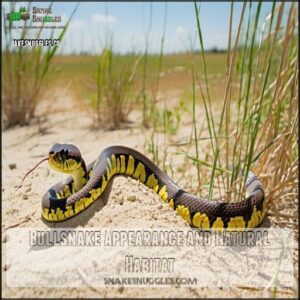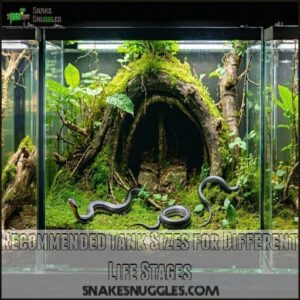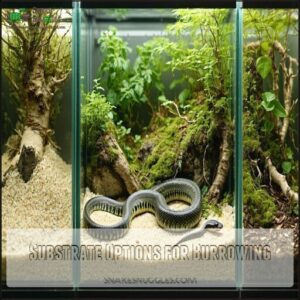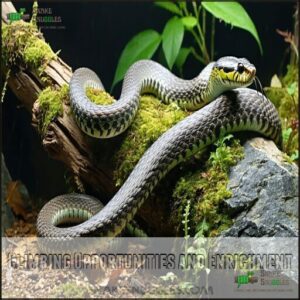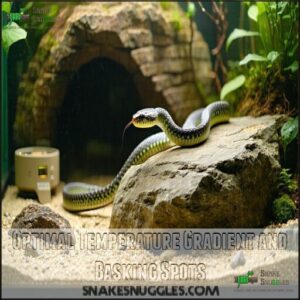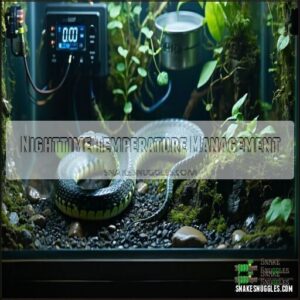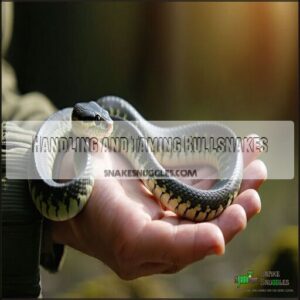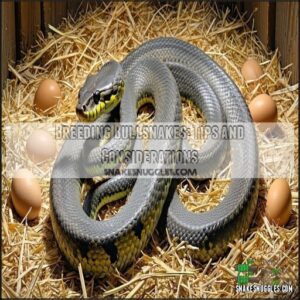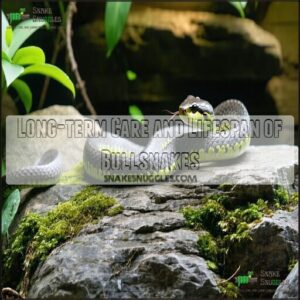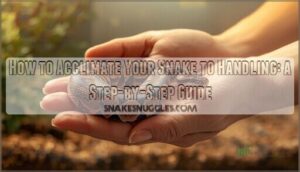This site is supported by our readers. We may earn a commission, at no cost to you, if you purchase through links.
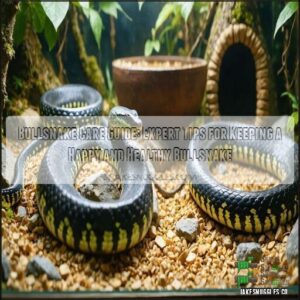
Start with a spacious enclosure—at least 4×2 feet for adults—lined with a burrowing-friendly substrate like aspen.
Maintain a temperature gradient of 75-85°F with a basking spot and provide multiple hide boxes for security.
Feed your bullsnake appropriately sized rodents, adjusting frequency as they grow, and always offer fresh water.
Handle them gently to build trust but watch for defensive behaviors, especially in new snakes.
Monitor health closely, looking for clear eyes, smooth shedding, and consistent activity.
There’s much more to learn about keeping these fascinating snakes happy!
Table Of Contents
- Key Takeaways
- Bullsnake Appearance and Natural Habitat
- Setting Up The Ideal Bullsnake Enclosure
- Maintaining Proper Temperature and Humidity Levels
- Feeding Your Bullsnake: Diet and Schedule
- Handling and Taming Bullsnakes
- Health Concerns and Common Bullsnake Diseases
- Breeding Bullsnakes: Tips and Considerations
- Long-term Care and Lifespan of Bullsnakes
- Frequently Asked Questions (FAQs)
- How to take care of bullsnakes?
- Are bullsnakes easy to keep?
- Are there any care sheets for bullsnakes?
- How often should I Feed my bullsnake?
- How often should a bullsnake enclosure be cleaned?
- How do you tame a bullsnake?
- Are bull snakes easy to care for?
- Do bull snakes need a heat lamp?
- How often should I feed a bullsnake?
- How often should you feed a bullsnake?
- Conclusion
Key Takeaways
- Set up a spacious enclosure with a temperature gradient of 75-85°F, burrowing-friendly substrate like aspen, and multiple hides for security.
- Feed appropriately sized rodents based on your bullsnake’s size and growth, and adjust feeding frequency as needed.
- Handle your snake gently to reduce stress, build trust, and watch for defensive behaviors like hissing or tail vibrations.
- Monitor health closely by ensuring smooth shedding, clear eyes, and consistent activity, and maintain proper humidity levels around 30-50%.
Bullsnake Appearance and Natural Habitat
Bullsnakes are large, nonvenomous snakes known for their striking yellow and brown patterns and impressive size, often reaching 4 to 7 feet long.
Bullsnakes boast bold yellow and brown patterns and can grow up to 7 feet, combining beauty with impressive size.
They thrive in sandy prairies, open woodlands, and arid scrublands across North America, where their burrowing skills help them hunt and stay safe.
Physical Characteristics and Size
Bullsnakes are one of North America’s largest snakes, showcasing an impressive adult size of 5 to 7 feet, with some rare individuals exceeding 8 feet.
Their sleek, muscular frame highlights their strength without appearing bulky. Hatchlings average 13 inches, growing quickly under proper care.
Bullsnakes feature dark saddle-like patterns on yellow to brown scales, adding to their distinct appearance. Their triangular head adds an air of confidence, while their tails, capable of vibrating like a rattlesnake’s, guarantee intimidation when threatened.
Muscular bodies, bold saddles, and rattlesnake-like tail vibrations make bullsnakes nature’s intimidating yet nonvenomous powerhouses in the wild.
- Adult size: 5–8 feet long
- Hatchling size: About 13 inches
- Weight range: 2–10 pounds
- Coloration: Yellow-brown with dark saddles
- Snake morphology: Triangular head, robust body
- Scale count: Prominent patterning
Color Variations and Patterns
The sheer variety of bullsnake morphs is fascinating.
You’ll notice snake colors ranging from a yellow base with bold blotches to stunning genetic morphs like Albino or Hypomelanistic.
These unique snake patterns also feature pattern aberrations influenced by localities and age.
For example, some regional variations reveal darker or softer scale markings, while rare types like Axanthic lack yellow pigments.
Each bullsnake morph highlights nature’s artistry, making them true visual marvels in every collection.
Native Range and Preferred Environments
Ever wonder where bullsnakes thrive?
These adaptable snakes call various environments home, from Canada to Mexico, thanks to their resourcefulness and resilience.
Their preferred habitats include:
- Grasslands teeming with prey like rodents and insects.
- Rocky outcrops offering shade and burrowing spots.
- Farmlands providing shelter and abundant food sources.
- Open fields accommodating movement and nesting needs.
Bullsnakes’ ability to adapt to diverse climates and environments makes them one of North America’s most versatile and fascinating reptiles.
Burrowing Behavior and Adaptations
Creating underground homes is a natural talent of bullsnakes, and their burrowing benefits both comfort and instinct.
Using their wide rostral scale, they excel at digging tunnels in sandy or loose soil, which supports their need for natural burrows and security.
To replicate this behavior in your bullsnake habitat, choose the right substrate. Aspen shavings, cypress mulch, or ground walnut husks encourage digging while keeping their snake environment natural and clean.
Each option has unique benefits—lightweight aspen shavings are easy to clean, cypress mulch retains moisture well, and walnut husks provide a textured look for active diggers.
Enclosure depth should allow enough space for burrowing activities.
Adding a burrow-friendly snake substrate supports their behavior and creates secure hiding spots, which are essential for a happy, healthy bullsnake.
Setting Up The Ideal Bullsnake Enclosure
Creating a proper enclosure for your bullsnake guarantees its health and well-being. You’ll need a secure, spacious habitat with the right temperature, hiding spots, and substrate for burrowing.
Recommended Tank Sizes for Different Life Stages
An appropriate tank size is key to proper bullsnake care and guaranteeing their well-being.
Hatchling enclosure size should start with a 10-gallon tank, while juveniles need larger tanks with sufficient growing room.
For adults, a snake enclosure size of at least 4x2x2 feet lets them thrive. Focus on ground space over height due to minimal vertical space needs, and guarantee sturdy, escape-proof lids.
- Hatchling needs: 10-gallon tanks work best.
- Juveniles: Shift to intermediate enclosures.
- Adult cage requirements: Minimum 4x2x2 feet.
- Burrowing space: Provide deep substrates.
- Ventilation: Supports both health and enrichment.
Essential Equipment and Accessories
The right setup is essential for a healthy bullsnake enclosure.
Start by providing hide boxes at both ends of the cage—one on the warmer side and one on the cooler side—to offer your snake places to rest and feel secure.
For heating, use lamps, pads, or ceramic emitters, but always connect them to a thermostat to control the snake temperature safely.
Include a spacious water bowl for drinking and relaxing.
Add practical accessories like snake hooks for safe handling and thermometers to monitor temperature.
Lighting is also important—use bulbs to create a natural day/night cycle.
A well-equipped snake enclosure guarantees comfort while mimicking natural conditions, keeping your bullsnake healthy and stress-free.
Many owners find that a quality hide box is essential for the snake’s well-being.
Substrate Options for Burrowing
Choosing the best substrate for your bullsnake enclosure is essential for their well-being.
Substrate options like aspen bedding, loose sand, or cypress mulch allow safe burrowing while supporting natural behaviors. Avoid sharp or dusty sands, as they can irritate your snake.
- Aspen bedding: Easy to clean and absorbs odor.
- Cypress mulch: Retains humidity but spot-clean often.
- Sand concerns: Maintain a deep, smooth layer for digging.
Maintain proper humidity without overwatering to keep burrows intact.
Importance of Multiple Hide Boxes
Hide boxes are a must-have in any well-planned bullsnake enclosure, serving as safe spots for stress reduction and behavioral enrichment.
You’ll want at least two—one on the warm side and another on the cool side—for effective thermoregulation aid.
Place the hide boxes where your bullsnake can feel secure, replicating the natural shelters it seeks in the wild.
Extra touches like visual barriers or partially covering the hides can enhance snake security and create a more comforting environment.
These hiding places are more than accessories; they’re a cornerstone of bullsnake care.
Whether it’s seeking warmth or coolness, your snake will appreciate these retreats.
A thoughtfully designed hide placement guarantees a happy, stress-free home for your pet.
Climbing Opportunities and Enrichment
A bullsnake’s enclosure doesn’t have to be flat and dull—adding vertical space keeps things engaging! While bullsnakes aren’t champion climbers, they’ll enjoy exploring safe climbing materials like driftwood, sturdy branches, or rock formations.
These additions promote mental stimulation and boost their overall well-being. Use stable, secure materials to avoid falls. Arrange branches at shallow angles, ensuring they’re well-placed for easy climbing.
Rotate enrichment items periodically to keep things fresh, as a dynamic environment prevents boredom. Here’s what to try:
- Driftwood or natural branches: Perfect for adding texture and height.
- Rock platforms: Great for basking or slithering over sturdy surfaces.
- Textured ramps or logs: Keep snakes curious and engaged.
A well-enriched enclosure means a healthier, happier bullsnake!
Maintaining Proper Temperature and Humidity Levels
To keep your bullsnake healthy, you’ll need to provide the right temperature and humidity levels in its enclosure.
Proper heating and monitoring tools guarantee a comfortable environment that supports digestion, shedding, and overall well-being.
Optimal Temperature Gradient and Basking Spots
To keep your bullsnake thriving, focus on its temperature requirements. Create a gradient using heating devices, keeping a basking spot at 87°F during the day while cooler areas stay at 75°F.
Nighttime temperature drop is key—maintain 80°F on the warm side and 70°F on the cool end. Use reliable temperature monitoring methods to verify accuracy.
Seasonal temperature adjustments may boost overall health. Proper gradient establishment techniques support digestion, energy levels, and overall comfort for your bullsnake, ensuring a healthy and thriving environment with the right temperature settings.
Heating Equipment Options (lamps, Pads, Emitters)
A proper heating setup keeps your bullsnake healthy and comfortable.
Use a variety of devices to replicate natural warmth in its enclosure.
- Basking Bulb Types: Heat lamps provide daytime warmth and basking spots.
- Ceramic Heat Emitters: Maintain nighttime temperatures without bright light.
- Snake Heating Pads: Gentle, consistent heat underneath the enclosure for belly warmth.
- Thermostat Control: Prevent overheating and manage your temperature gradient setup effectively.
Always pair these snake external heat sources with a thermostat to guarantee safe, steady temperatures and avoid accidents.
Many options exist for reptile heat sources on the market.
Monitoring Tools and Techniques
Tracking your snake’s environment is simple with helpful tools. Accurate temperature sensors like digital thermometers guarantee heating stays steady, while humidity gauges keep moisture levels ideal.
Aim for 87°F on the warm side and 75°F on the cool side during the day, with nighttime dropping slightly to 80°F and 70°F. A good option is to use a reptile-specific thermometer to guarantee accurate readings.
- Use these techniques for successful monitoring:
- Regularly test thermometers and hygrometers for accuracy.
- Track shedding and behavior patterns for clues about discomfort.
- Log environmental changes during seasonal shifts.
- Guarantee proper ventilation without disrupting temperature gradients.
Stay consistent, and your snake will thrive in a well-managed habitat!
Humidity Requirements and Adjustments for Shedding
Shedding issues often trace back to poor humidity. For healthy bullsnake shedding, aim for 30–40% humidity on normal days and 40–50% during shedding.
Place damp moss in a hide for extra moisture—it’s effective and stress-free.
Here’s a quick guide:
Stage Humidity Range Helpful Tip
Humidity Monitoring guarantees smooth snake shedding while keeping their skin healthy!
Nighttime Temperature Management
A drop in nighttime temperatures is natural and healthy for bullsnakes, mimicking their wild environment. Aim for a snake temperature gradient of 80°F on the warm side and 70°F on the cool side to promote digestion and upkeep their health.
Using ceramic heat emitters or under-tank heating mats is ideal because they provide steady warmth without light, keeping the enclosure dark and peaceful. Bright heat lamps at night? Skip those—they’ll disturb your snake’s rest.
Instead, rely on thermostats to regulate heating alternatives and maintain consistency. Double-check the setup with thermometers or temp guns to avoid guesswork.
- Use a timer for precise thermostat settings.
- Insulate the enclosure for stable seasonal adjustments.
- Monitor warm and cool sides individually.
- Maintain 30-40% humidity for ideal bullsnake care.
Feeding Your Bullsnake: Diet and Schedule
Feeding your bullsnake the right diet on a proper schedule is essential for its health and growth.
You’ll need to provide appropriately sized prey items and adjust feeding frequency as your snake matures.
Appropriate Prey Items and Sizes
Feeding your bullsnake? Focus on matching the prey size to the snake’s widest point for healthy digestion. Frozen/thawed rodents are best—safer and easier than live prey.
Here’s a quick guide:
| Prey Type | Snake Size | Feeding Frequency | Note |
|---|---|---|---|
| Pinky mice | Hatchlings | Every 5 days | Easy to digest |
| Fuzzy mice | Juveniles | Every 7 days | Gradually larger prey |
| Adult rodents | Adults | Every 10 days | Keeps them in shape |
| Small rats | Large adults | Every 10 days | Occasional variety |
Choose wisely for balanced bullsnake nutrition!
Feeding Frequency for Different Life Stages
A bullsnake’s diet and feeding frequency should match its life stage.
Hatchlings need feeding every 4-5 days for steady growth, juveniles stick to weekly schedules, and adults eat every 7-14 days.
Providing meals of the right size is key to preventing obesity and supporting brumation feeding.
- Why this matters:
- Prevents overfeeding and obesity.
- Keeps growth steady and healthy.
- Reduces snake food costs long-term.
Pros and Cons of Live Vs. Frozen/thawed Prey
Choosing between live rodents and frozen-thawed options for a bullsnake diet depends on safety, convenience, and your snake’s preference.
Live prey may provide natural hunting stimulation but comes with risk factors like bites or injuries. Frozen-thawed rodents are safer, easier to store, and maintain comparable nutritional value.
- Minimize injuries: Frozen-thawed prey eliminates harm from defensive live rodents.
- Boost convenience: Easier storage and availability reduce snake feeding stress.
- Consider cost: Frozen prey can lower long-term feeding expenses.
Smart choices improve safety and meet ethical concerns effectively.
Avoiding Overfeeding and Obesity
You’ll want to keep your bullsnake active and healthy by avoiding overfeeding, which can lead to obesity and sluggishness.
Portion control is key—choose prey no wider than 1.5 times your snake’s thickest part. Stick to a feeding schedule: hatchlings eat every 5-7 days, adults every 7-10 days.
Monitor their shape regularly for signs of snake fat or poor health. One key consideration is to prevent improper thawing practices when preparing frozen meals.
- Watch for changes: A round midsection can indicate obesity risks.
- Weigh them often: Regular weighing tracks snake health.
- Adjust as needed: Tailor the bullsnake diet as they grow.
Supplementation and Nutritional Considerations
Supplementation is key to a balanced snake diet.
Dust snake live food or snake frozen food with calcium powder every 2–3 meals to prevent deficiencies.
A multivitamin with Vitamin D3 supports gut health and should be used monthly.
Here’s a quick reference:
| Frequency | Supplement | Purpose |
|---|---|---|
| Every 2–3 meals | Calcium Powder | Strong bones |
| Monthly | Multivitamin + D3 | Gut health |
| Quarterly | Mineral Boosts | Nutrition balance |
| Always | Hydration Methods | Prevent dehydration |
| Adjust as needed | Feeding Techniques | Obesity prevention |
These simple steps keep your bullsnake thriving with proper hydration methods and feeding techniques.
Handling and Taming Bullsnakes
Handling your bullsnake regularly helps build trust and reduces stress, making them more comfortable around you.
With patience and proper techniques, you can guarantee safe, enjoyable interactions for both you and your snake, which leads to enjoyable experiences.
Proper Handling Techniques and Safety Precautions
Handling your bullsnake with care keeps both of you safe.
Always approach slowly and confidently, supporting its entire body to avoid stress. If it hisses or vibrates its tail, don’t force interaction—these are clear signals to pause.
- Safe Restraint: Use a hook for wilder snakes initially.
- Reading Signals: Learn its mood—calm snakes handle better.
- Avoiding Bites: Slow movements prevent defensive strikes.
- Hygiene Practices: Wash hands before and after handling to prevent germs.
Stay calm and patient for smooth handling sessions.
Socialization Strategies for Young Snakes
Socializing a young bullsnake takes time and patience, but it helps build trust and improves temperament. Start slow and stay consistent to make your snake feel at ease during handling.
- Early Handling: Begin handling your bullsnake when it’s young. Keep initial sessions short, about 5-10 minutes, to build comfort without overwhelming them.
- Gradual Exposure: Handle your snake in a quiet, safe spot. Avoid sudden movements or loud noises, which can cause stress. Support the snake’s body using gentle, confident gestures.
- Positive Reinforcement: Associate handling with positive experiences—move calmly, avoid squeezing, and let your snake explore at their pace.
Pay attention to snake behavior during interactions. Tongue flicking shows curiosity, while retreating signals stress.
Gradually extend handling time as your bullsnake becomes more confident. Creating stress-free handling sessions early on will foster a calm, social bullsnake temperament over time.
Recognizing and Responding to Defensive Behaviors
Bullsnakes use defensive behaviors like tail vibration, hissing, and bluff striking to mimic aggression when they feel threatened.
These behaviors aren’t true aggression—they’re more like a survival bluff. For example, hissing interpretation reveals discomfort, warning you to move slowly and avoid sudden gestures. Tail vibration often mimics rattlesnakes, signaling fear rather than a wish to bite.
If the snake flattens its head, it’s trying to appear more intimidating.
To handle these moments, stay calm, approach confidently, and give your bullsnake time to relax. Never escalate stress.
Recognizing defensive behavior builds trust and improves bullsnake handling. Patience is key to reducing stress and understanding bullsnake temperament with each interaction.
Building Trust and Reducing Stress During Interactions
Building trust with your bullsnake takes patience and understanding of its natural behavior. These snakes aren’t aggressive by nature, but defensive displays can appear intimidating.
Gentle handling and gradual introduction are key to reducing stress and promoting comfort during interactions. Start by respecting the snake’s boundaries and giving it time to adjust. Positive reinforcement—like consistent, calm handling—helps build confidence.
Always prioritize snake safety precautions when interacting.
- Approach slowly and avoid sudden movements that might frighten.
- Allow the snake to explore without forcing engagement.
- Pay attention to signals, such as hissing or retreating, that indicate stress.
- Provide a secure space where the snake feels safe between sessions.
- Focus on short, calm sessions, increasing duration gradually.
Frequency and Duration of Handling Sessions
Trust starts with how often and how long you handle your bullsnake. Over time, handling builds confidence and reduces stress for both you and your snake.
Here’s a quick guide to create positive interactions:
- Handle regularly: Aim for 2-3 short sessions each week to reinforce trust.
- Limit session duration: Keep handling sessions to 5-10 minutes, especially with younger snakes, to avoid overwhelming them.
- Stay observant: Watch for signs of discomfort, like hissing or tail vibrations, to prevent aggression.
- Be confident: Bullsnakes can sense hesitation. A calm approach improves their temperament over time.
Consistent, patient efforts lead to a docile, cooperative snake.
Health Concerns and Common Bullsnake Diseases
Keeping your bullsnake healthy means watching for common issues like shedding problems, respiratory infections, and parasites.
Understanding the signs of illness and knowing when to seek veterinary care will help guarantee your snake thrives, which is crucial for keeping your bullsnake healthy.
Signs of a Healthy Bullsnake
A healthy bullsnake has clear eyes, smooth scales, and vibrant color.
Its body condition should feel firm and muscular—not thin or weak.
Watch for alert behavior—it should explore curiously and respond to handling calmly.
Proper shedding quality indicates good care, with no patches left behind.
| Trait | Healthy Sign | Warning Sign |
|---|---|---|
| Body Condition | Firm, muscular | Weak, thin |
| Skin Appearance | Smooth, vibrant | Dull, flaky, discolored |
| Eyes | Bright, clear | Cloudy, sunken |
| Activity | Curious, responsive | Sluggish, lethargic |
Maintain regular appetite and hygiene to guarantee top bullsnake health.
Common Respiratory Infections and Treatments
Respiratory issues in bullsnakes can creep up quietly but quickly affect their health.
Watch for these infection symptoms:
- Wheezing or gurgling sounds
- Open-mouth breathing
- Nasal discharge
A snake doctor may prescribe antibiotic options and nebulization therapy.
Stabilize humidity levels and cage conditions for recovery. Pneumonia often stems from poor care, so adopt preventative measures like maintaining stable temperatures, cleaning enclosures, and guaranteeing proper airflow.
Quick action guarantees better bullsnake health and keeps respiratory diseases at bay.
Parasitic Infestations and Prevention
Parasites like snake mites and worms can harm your bullsnake if you’re not careful.
Look for mites around the eyes or tiny moving specks under scales. Act quickly with proper treatments.
Use quarantine protocols for new snakes to avoid spreading bullsnake diseases. Keep habitats spotless and bedding clean to prevent infections.
Schedule vet check-ups early to catch issues like internal parasites.
| Type of Parasite | Signs | Treatment |
|---|---|---|
| Snake Mites | Specks on scales, eyes | Mite sprays or soaks |
| Internal Parasites | Weight loss, lethargy | Deworming medications |
| Ticks | Visible on skin | Manual removal, cleanliness |
To prevent and treat parasites effectively, it is crucial to be aware of the signs and proper treatments. This includes recognizing the importance of cleanliness in preventing the spread of diseases.
Shedding Problems and Solutions
Bullsnakes shedding improperly signals a humidity issue. When their eyes cloud over, shedding’s near—help them out! Keep enclosure humidity levels around 40–50% to prevent stuck shed or retained eyecaps. A damp hide box can help maintain moisture. Light spraying works when things feel too dry.
Environmental factors, such as humidity imbalances, can lead to incomplete shedding.
- **Check for stuck shed or leftover patches.
- **Provide shedding aids like soft bedding.
- **Gently remove stuck skin using a wet cloth.
- **Address mites causing shedding troubles.
- **Increase snake care with regular humidity checks.
When to Seek Veterinary Care
Even with great care, your bullsnake might need a snake doctor visit.
Watch for key snake health indicators like lethargy, refusal to eat, abnormal shedding, or labored breathing.
Breathing issues or sudden inactivity, for example, often mean an immediate snake doctor visit is necessary.
If you notice visible injuries, weight loss, or signs of a snake infection, don’t wait—schedule care promptly.
Persistent shedding problems or unexplained behavior shifts, like aggression, may hint at snake injuries or illness.
Quick action guarantees faster snake bite treatment and recovery.
Breeding Bullsnakes: Tips and Considerations
Breeding bullsnakes requires careful planning to guarantee the health and well-being of both adults and hatchlings.
Understanding their breeding cycles, environmental needs, and proper care for eggs will set you up for success.
Determining Sexual Maturity and Breeding Readiness
Knowing when your bullsnake is ready for breeding relies on Age Factors, health, and observant care.
It’s not just about age—it’s about meeting multiple checkpoints:
- Age Matters: Males mature at 1-2 years, females at 3-5 years.
- Physical Indicators: Confirm your bullsnake reaches 4-7 feet in length.
- Reproductive Cycles: Females older than three produce stronger clutches.
- Mating Behavior: Look for increased activity in breeding seasons.
- Health Check: Consult a vet to confirm readiness and hormone levels.
These snake breeding practices help guarantee safe, successful results!
Creating Optimal Breeding Conditions
Creating ideal bullsnake breeding conditions starts with cycling their environment to mimic natural seasons.
Gradually lower temperatures for brumation to encourage reproductive readiness. Afterward, introduce the male and female during their active phase.
Monitor their interaction closely for successful mating but separate them afterward to reduce stress.
To guarantee proper egg development, maintain incubator temperature control. This approach guarantees healthier snakes and boosts your chances of producing robust hatchlings.
Egg Incubation Techniques and Requirements
To successfully incubate bullsnake eggs, maintain a steady incubation temperature of 76–82°F.
Place eggs on a damp substrate like vermiculite for proper humidity control, preventing dryness or mold.
Avoid egg turning, as it can harm embryos.
With consistent conditions and patience during the 50–60 day snake incubation period, you’ll soon see healthy hatchlings emerge, ready for your care.
Caring for Hatchlings and Juveniles
How do you make certain your bullsnake hatchlings thrive? Start with a small, safe enclosure lined with aspen or cypress mulch, which promotes natural burrowing behavior.
Maintain temperatures between 75–85°F, and provide at least two snug hides for security and stress reduction.
Hatchling feeding is straightforward—offer appropriately sized pinkie mice every 5 days. Always choose prey that’s not too large for their small jaws. Frozen/thawed rodents are safer and reduce the risk of injury or disease.
Handle your snake young briefly and gently to build trust. Hatchlings may bluff or hiss at first, but regular interaction helps them calm down over time. Monitor their growth consistently, upgrading juvenile housing and prey sizes as needed.
- Ideal Habitat: Small tank with mulch and secure hides.
- Feeding Frequency: Pinkie mice every five days.
- Growth Monitoring: Adapt housing as they grow.
- Shedding Care: Maintain humidity for smooth skin transitions to guarantee a healthy molt.
Genetic Considerations and Morph Production
Creating unique bullsnake morphs is a rewarding aspect of breeding, blending art with science.
By understanding morph genetics and traits like recessive inheritance, you’ll reveal beautiful designs like albino or hypo morphs.
Selective breeding guarantees offspring are healthy while achieving desired patterns and colors.
Breeders often use captive breeding to study future trends and expand availability.
A genetics calculator can help plan pairings efficiently.
Avoid inbreeding by introducing fresh bloodlines regularly.
Here’s a handy table highlighting key terms:
| Term | Definition | Example Morphs |
|---|---|---|
| Recessive Traits | Require two carrier genes | Albino, Hypo |
| Selective Breeding | Pairing for specific traits | Designer Morphs |
| Future Trends | Popular morph preferences | Super Stripes, Axanthic |
Healthy planning creates vibrant, lasting morphs!
Long-term Care and Lifespan of Bullsnakes
Caring for a bullsnake is a long-term commitment, as they can live over 20 years in captivity.
By maintaining their health, adapting their care as they age, and providing enrichment, you can help them thrive throughout their lifespan.
Expected Lifespan in Captivity
Bullsnake lifespan in captivity ranges from 15 to 25 years, far surpassing their shorter time in the wild.
Factors like genetic predisposition, environmental stability, and proper husbandry greatly impact snake longevity.
A well-balanced diet, a clean enclosure, and regular monitoring are key to extending lifespan.
Good bullsnake care means creating a stress-free, stable habitat—vital for their health, shedding, and overall happiness as they thrive in captivity.
Adjusting Care for Aging Snakes
As your bullsnake ages, you’ll notice reduced activity and potential joint issues.
Adjust their care to support these changes, switch to smaller prey portions to ease digestion and reduce snake feeding frequency.
Modify their enclosure by lowering climbing areas and adding soft substrates for comfort. Make certain hides are easy to access for resting.
Monitor their preferences within the temperature gradient, as older snakes may rely on warmer spots, and regularly assess their condition since proper bullsnake care is key to enhancing snake longevity and guaranteeing their comfort.
Importance of Regular Health Check-ups
Keeping your snake healthy isn’t just about a clean tank or feeding schedule—it’s about spotting changes that might signal bigger issues.
Regular health check-ups are a cornerstone of bullsnake care, offering peace of mind and helping prevent hidden problems.
Here’s why scheduling routine vet visits matters:
- Parasite Prevention: Catch parasitic infestations early, avoiding discomfort and long-term complications.
- Early Detection: Address respiratory infections, shedding issues, or other health concerns before they become serious.
- Weight Monitoring: Verify your snake maintains a healthy weight, especially as overfeeding or underfeeding can lead to health problems.
- Behavioral Changes: Learn how shifts in activity or feeding habits reflect your snake’s well-being.
A vet’s expertise complements your day-to-day observations, keeping those scales shiny and their bellies full.
With proper snake hygiene, frequent monitoring, and professional guidance, your bullsnake can enjoy a healthy, happy life.
Environmental Enrichment for Longevity
Creating a stimulating environment is essential for promoting your bullsnake’s mental and physical well-being, helping it thrive in captivity and supporting a long lifespan.
Thoughtful changes to the enclosure encourage natural behaviors like climbing, burrowing, and exploring. Variety is key—mix things up often to keep your snake curious. Olfactory enrichment can further stimulate curiosity through novel scents.
- Enhance Enclosure Complexity: Rearrange items regularly or add climbing structures like branches or cork bark.
- Support Natural Behaviors: Incorporate burrowing opportunities with substrates like shredded aspen or sand.
- Offer Mental Stimulation: Use tunnels, rocks, or textured hides to spark exploration.
- Balance Temperature Zones: Guarantee proper snake environmental conditions for easy thermoregulation.
When snake habitats align with their instincts, you’re enriching their lives for true snake longevity.
Frequently Asked Questions (FAQs)
How to take care of bullsnakes?
With an average lifespan of 20 years, bullsnakes thrive in a 4’x2’ enclosure, 78°F temps, and aspen bedding.
They need hides, climbing structures, regular handling, and spot cleaning for a calm, healthy life.
Are bullsnakes easy to keep?
They’re surprisingly low-maintenance pets with the right setup.
They flourish in simple enclosures, need minimal handling, and adapt well to captivity.
Just keep their temperature and habitat right, and they’ll thrive for years!
Are there any care sheets for bullsnakes?
You’ll find detailed bullsnake care sheets online from reptile forums, pet websites, or breeders.
They cover housing, feeding, temperature, and handling tips, making them helpful for creating a healthy, stress-free environment for your snake.
How often should I Feed my bullsnake?
Think of feeding like clockwork for their health.
Offer meals every 10-14 days for adults, adjusting based on size and growth.
Hatchlings eat weekly.
Stick to appropriately sized prey, slightly larger than the snake’s widest part.
How often should a bullsnake enclosure be cleaned?
Clean the bullsnake enclosure monthly, but spot-clean as needed for spills or waste.
Replace water daily and make certain no uneaten food lingers.
Keeping the habitat clean reduces stress and promotes your snake’s overall health.
How do you tame a bullsnake?
Taming a bullsnake? Patience is your best tool.
Handle it gently but regularly, starting with short sessions.
Confidence matters—move slow, avoid sudden grabs, and never after feeding.
Over time, trust builds, and calmness follows.
Are bull snakes easy to care for?
Yes, bull snakes are fairly easy to care for.
They’re hardy, low-maintenance, and adapt well to captivity.
With proper handling, housing, and feeding, they make rewarding pets even for beginners, despite their large size.
Do bull snakes need a heat lamp?
Bull snakes don’t strictly need a heat lamp, but they do require warmth.
You can use a heating pad or bulb to maintain a gradient of 75–87°F, keeping them healthy and comfortable in their enclosure.
How often should I feed a bullsnake?
Feed your bullsnake once every 7-10 days, depending on its age and size.
Hatchlings need smaller, more frequent meals, while adults can go longer between feedings.
Always adjust portions to maintain healthy weight and activity.
How often should you feed a bullsnake?
In terms of feeding, aim for every 7-10 days, depending on age and size.
Hatchlings need smaller, more frequent meals, while adults can enjoy larger prey less often, keeping them healthy and content.
Conclusion
Caring for a bullsnake is like cultivating a garden—it’s all about creating the right conditions for thriving.
With a proper enclosure, steady temperature, and well-planned feeding schedule, your bullsnake will remain healthy and active.
Pay attention to their behaviors and needs, offering hide boxes, fresh water, and gentle handling to build trust.
Regular monitoring guarantees they stay disease-free and happy, and a little effort goes a long way in providing excellent bullsnake care and a fulfilling experience for both of you, which is key to creating the right conditions for your bullsnake to thrive.

